379. Barred Long-tailed Cuckoo Cercococcyx montanus (Langstertkoekoek)
Order: Cuculiformes. Family: Cuculidae
Description
32-34 cm. A long-tailed cuckoo. Told by long tail plus brown and tawny colouring. Upperparts brown and barred rufous. Wing barred. Whitish underparts sharpely barred black, undertail coverts pale buff, with a few brown bars. Olive brown head. Cream throat. Extent of buff on throat and vent is variable. Yellow legs. Brown eyes.
Juveniles are more barred above with a darker throat, and less defined below; they are not distinguishable from other long-tailed juvenile cuckoos.
Similar species: Much smaller-bodied than either the African Cuckoo or Common Cuckoo.
Distribution
Occurs from southern Kenya to Tanzania, Malawi and northern and central Mozambique, as well as northern and south-eastern Zimbabwe.
Taxonomy
There are 2 subspecies
C. m. montanus: Montane forests of south-western Uganda, eastern Zaire and Rwanda
C. m. patulus: Montane forests of Kenya to southern Zaire, Zambia and Mozambique
Habitat
It generally prefers dense riverine forest with deciduous thickets, munondo (Julbernadia), coastal thickets and lowland evergreen forest.
Movements and migrations
Rare summer visitor to the forests of Zimbabwe and Mozambique.
Diet
Mainly eats caterpillars and other small invertebrates such as small snails, doing most of its foraging in the tree canopy.
Breeding
Breeds probably in the rainy season. A brood parasitic. Suspected host species are Sharpe's Akalat and African Broadbill.
Call
A 4-note Piet-Piet-my-vrou.
Status
Rare summer visitor and resident.
Africa Wild Bird Book
Barred Long-tailed Cuckoo Photos
379. Barred Long-tailed Cuckoo Cercococcyx montanus
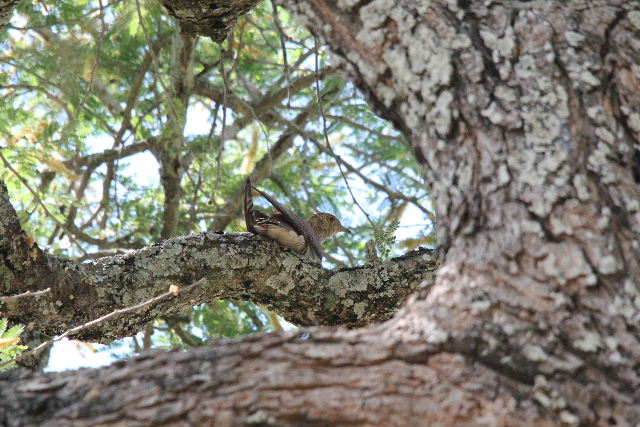 © pooky
© pooky
Mana Pools National Park, Zimbabwe
Links:
Sabap1
Sabap2
SASOL VOELS VAN SUIDER AFRICA (3de UIT)
 © pooky
© pookyMana Pools National Park, Zimbabwe
Links:
Sabap1
Sabap2
SASOL VOELS VAN SUIDER AFRICA (3de UIT)
Black Cuckoo
378. Black Cuckoo Cuculus clamosus (Swartkoekoek)
Order: Cuculiformes. Family: Cuculidae
Description
31 cm; male 78–103·5 g, female 78–102·7 g. Adult black above, glossed greenish blue, looks all black at distance; undertail barred with buff; underwing mottled and barred with white; edge of wing white; rare colour form barred with rufous on underparts. Iris dark brown; bill blackish horn; legs and feet dark pinkish brown.
Juvenile: Sooty black to brownish; no white on tail.
Chick: Naked dark purplish; nostril round, prominent; back flat (not hollowed).
Distribution
Africa S of Sahara; in South Africa absent from most of dry W; regular in SW Cape.
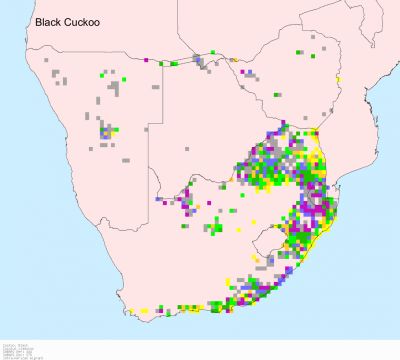
Habitat
It generally prefers forest edges, woodland, riverine bush, exotic plantations, farmland, suburban areas.
Movements and migrations
Intra-African breeding migrant, arriving in southern Africa from September-October, and eventually departing for its non-breeding grounds around January.
Diet
The Black cuckoo's diet consists mostly of insects, especially caterpillars, but it also eats the eggs and sometimes chicks of its host.
Breeding
It is a brood parasite, meaning that it lays its eggs in other birds nests. The host, thinking that the egg is its own, incubates the egg and cares for the chick. The following bird species have been recorded as hosts of the Black cuckoo: Tropical Boubou, Crimson-breasted Shrike, Southern Boubou, other Laniarius shrikes. Egg-laying season peaks from November-December in most areas except Namibia, where it peaks around February-March.
The female removes any existing eggs in the host's nest before laying one of her own. It lays eggs in clutches of four, one laid every two days. In total, the female typically lays around 22 eggs in one breeding season. The chick removes any existing eggs in the host's nest a few days after hatching. It stays in the nest for about 20-21 days, becoming fully independent at 39-64 days old.
Call
Mournful monotonous mellow whistle of 2-3 syllables, rising in pitch on drawn-out last note, hoop-hoo whooo
Status
Common summer resident.
Order: Cuculiformes. Family: Cuculidae
Description
31 cm; male 78–103·5 g, female 78–102·7 g. Adult black above, glossed greenish blue, looks all black at distance; undertail barred with buff; underwing mottled and barred with white; edge of wing white; rare colour form barred with rufous on underparts. Iris dark brown; bill blackish horn; legs and feet dark pinkish brown.
Juvenile: Sooty black to brownish; no white on tail.
Chick: Naked dark purplish; nostril round, prominent; back flat (not hollowed).
Distribution
Africa S of Sahara; in South Africa absent from most of dry W; regular in SW Cape.

Habitat
It generally prefers forest edges, woodland, riverine bush, exotic plantations, farmland, suburban areas.
Movements and migrations
Intra-African breeding migrant, arriving in southern Africa from September-October, and eventually departing for its non-breeding grounds around January.
Diet
The Black cuckoo's diet consists mostly of insects, especially caterpillars, but it also eats the eggs and sometimes chicks of its host.
Breeding
It is a brood parasite, meaning that it lays its eggs in other birds nests. The host, thinking that the egg is its own, incubates the egg and cares for the chick. The following bird species have been recorded as hosts of the Black cuckoo: Tropical Boubou, Crimson-breasted Shrike, Southern Boubou, other Laniarius shrikes. Egg-laying season peaks from November-December in most areas except Namibia, where it peaks around February-March.
The female removes any existing eggs in the host's nest before laying one of her own. It lays eggs in clutches of four, one laid every two days. In total, the female typically lays around 22 eggs in one breeding season. The chick removes any existing eggs in the host's nest a few days after hatching. It stays in the nest for about 20-21 days, becoming fully independent at 39-64 days old.
Call
Mournful monotonous mellow whistle of 2-3 syllables, rising in pitch on drawn-out last note, hoop-hoo whooo
Status
Common summer resident.
Black Cuckoo Photos
378. Black Cuckoo Cuculus clamosus
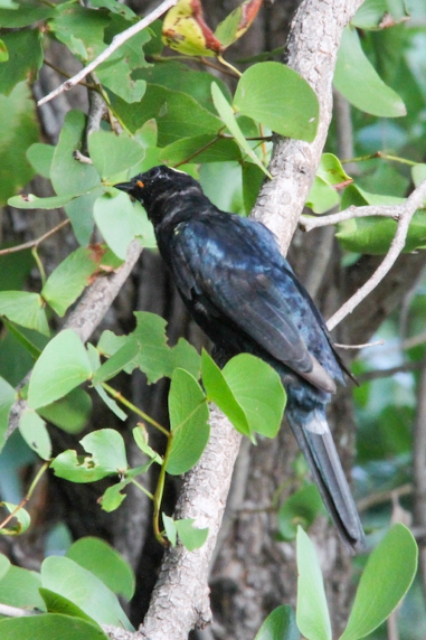 © Super Mongoose
© Super Mongoose
Leucistic Black Cuckoo
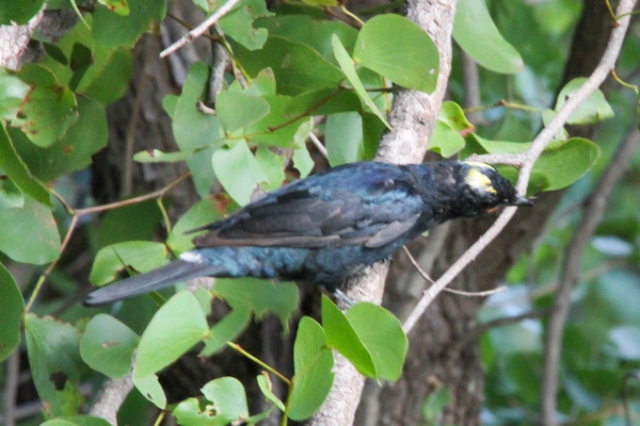 © Super Mongoose
© Super Mongoose
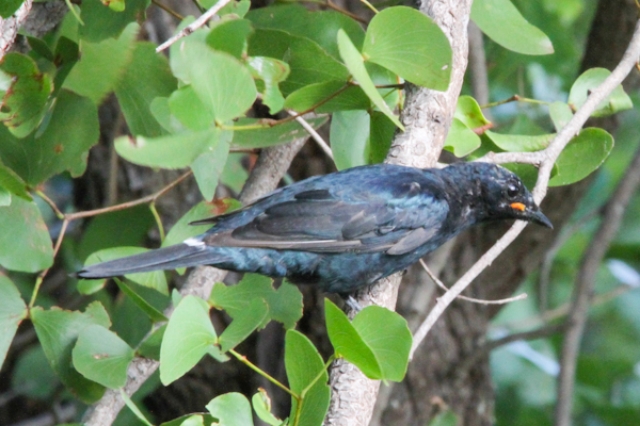 © Super Mongoose
© Super Mongoose
Kruger National Park, Mooiplaas Picnic spot
Links:
http://sabap2.adu.org.za/docs/sabap1/378.pdf
http://sabap2.adu.org.za/species_info.p ... #menu_left
Newman's Birds of Southern Africa
The Cuckoos
Plate
 © Super Mongoose
© Super MongooseLeucistic Black Cuckoo
 © Super Mongoose
© Super Mongoose © Super Mongoose
© Super MongooseKruger National Park, Mooiplaas Picnic spot
Links:
http://sabap2.adu.org.za/docs/sabap1/378.pdf
http://sabap2.adu.org.za/species_info.p ... #menu_left
Newman's Birds of Southern Africa
The Cuckoos
Plate
- Flutterby
- Posts: 44029
- Joined: Sat May 19, 2012 12:28 pm
- Country: South Africa
- Location: Gauteng, South Africa
- Contact:
Red-chested Cuckoo
377. Red-chested Cuckoo Cuculus solitarius (Piet-my-vrou)
Order: Cuculiformes. Family: Cuculidae
Description
Length 28-30 cm. Only cuckoo in the region with a rufous breast.
Adult: Dark grey head and back. The eye is brown with yellow eye-ring, the bill black, and the legs yellow. Rufous breast with grey chin and throat diagnostic. They are black above, with the white lower breast and belly heavily barred with black. Sexes are alike, but males generally larger than females.
Juveniles lack the rufous breast.
Similar species: Back darker than Common Cuckoo and African Cuckoo and paler than western form of Black Cuckoo.
Distribution
The Red-chested Cuckoo is found throughout Africa south of the Sahara, but avoids arid regions. In southern Africa it is a common breeding migrant in eastern Botswana, Zimbabwe, Mozambique, Swaziland and eastern and southern South Africa.
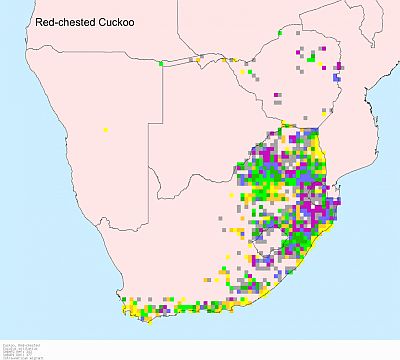
Habitat
Forests, exotic plantations, mature woodlands and suburban gardens.
Diet
Feeds mainly on invertebrates, especially hairy caterpillars, doing most of its foraging in the tree canopy. It occasionally goes down to the lower branches to pick up a scrap of food.
Breeding
It is a brood parasite, meaning that it lays its eggs in other bird nests. The host, thinking that the egg is its own, incubates the egg and cares for the chick. The following bird species have been recorded as host of the Red-chested Cuckoo: Cape Robin-chat (most common host), White-throated Robin-chat (3rd most common host), Bearded Scrub-robin, White-starred Robin, Cape Rock-thrush, African Dusky Flycatcher, Boulder Chat, Kurrichane Thrush, White-browed Robin-chat, White-browed Scrub-robin, Olive Thrush, Red-capped Robin-chat, Chorister Robin-chat, African Stonechat, Cape Wagtail (2nd most common host). Egg-laying season is from October-January. The female often has a hard time getting into the host's nest, as it is constantly mobbed and attacked. Amazingly, once it has got into the nest it can remove the host's egg and lay one of its own in less than 5 seconds! In one observation, the female laid 20 eggs in one breeding season. Once the chick is about two days old, it evicts the host's eggs and nestlings. It stays in the nest for 17-21 days, becoming fully independent 20-25 days later.
Call
The characteristic three-noted call during summer is often the only means of locating this bird as it sits motionless in thick foliage. Listen to Bird Call.
Status
Common summer visitor.
Order: Cuculiformes. Family: Cuculidae
Description
Length 28-30 cm. Only cuckoo in the region with a rufous breast.
Adult: Dark grey head and back. The eye is brown with yellow eye-ring, the bill black, and the legs yellow. Rufous breast with grey chin and throat diagnostic. They are black above, with the white lower breast and belly heavily barred with black. Sexes are alike, but males generally larger than females.
Juveniles lack the rufous breast.
Similar species: Back darker than Common Cuckoo and African Cuckoo and paler than western form of Black Cuckoo.
Distribution
The Red-chested Cuckoo is found throughout Africa south of the Sahara, but avoids arid regions. In southern Africa it is a common breeding migrant in eastern Botswana, Zimbabwe, Mozambique, Swaziland and eastern and southern South Africa.

Habitat
Forests, exotic plantations, mature woodlands and suburban gardens.
Diet
Feeds mainly on invertebrates, especially hairy caterpillars, doing most of its foraging in the tree canopy. It occasionally goes down to the lower branches to pick up a scrap of food.
Breeding
It is a brood parasite, meaning that it lays its eggs in other bird nests. The host, thinking that the egg is its own, incubates the egg and cares for the chick. The following bird species have been recorded as host of the Red-chested Cuckoo: Cape Robin-chat (most common host), White-throated Robin-chat (3rd most common host), Bearded Scrub-robin, White-starred Robin, Cape Rock-thrush, African Dusky Flycatcher, Boulder Chat, Kurrichane Thrush, White-browed Robin-chat, White-browed Scrub-robin, Olive Thrush, Red-capped Robin-chat, Chorister Robin-chat, African Stonechat, Cape Wagtail (2nd most common host). Egg-laying season is from October-January. The female often has a hard time getting into the host's nest, as it is constantly mobbed and attacked. Amazingly, once it has got into the nest it can remove the host's egg and lay one of its own in less than 5 seconds! In one observation, the female laid 20 eggs in one breeding season. Once the chick is about two days old, it evicts the host's eggs and nestlings. It stays in the nest for 17-21 days, becoming fully independent 20-25 days later.
Call
The characteristic three-noted call during summer is often the only means of locating this bird as it sits motionless in thick foliage. Listen to Bird Call.
Status
Common summer visitor.
- Flutterby
- Posts: 44029
- Joined: Sat May 19, 2012 12:28 pm
- Country: South Africa
- Location: Gauteng, South Africa
- Contact:
Red-chested Cuckoo Photos
377. Red-chested Cuckoo Cuculus solitarius
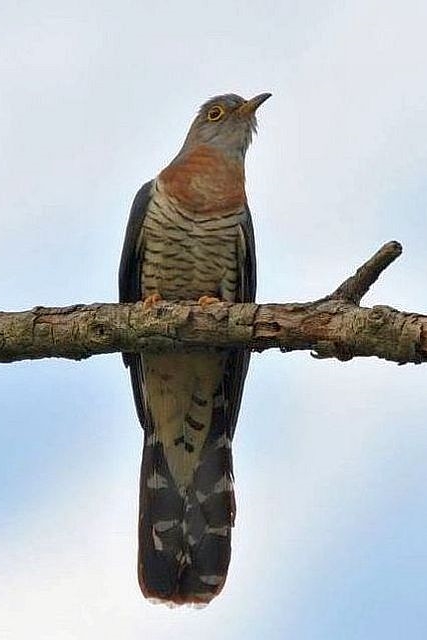 © Lowveldboy
© Lowveldboy
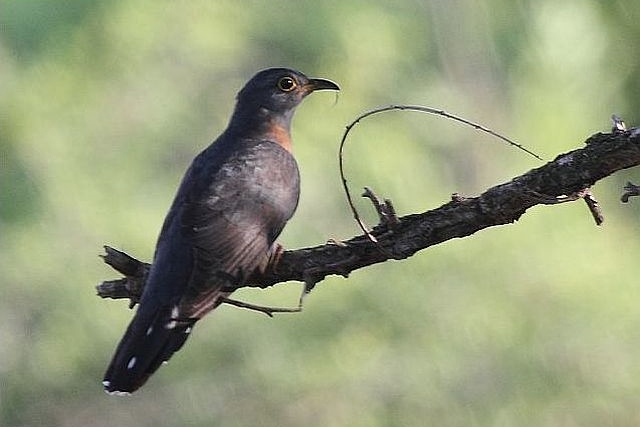 © Duke
© Duke
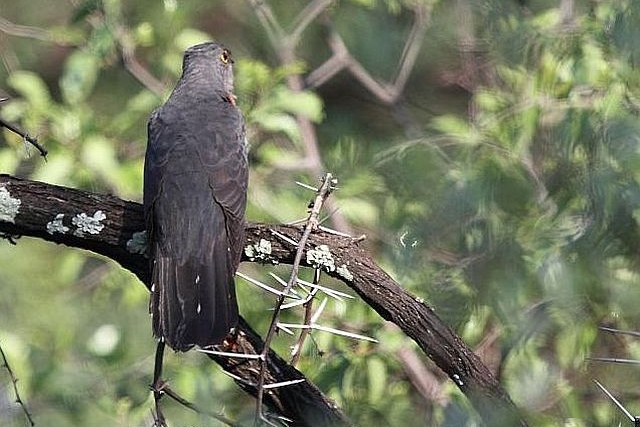 © Duke
© Duke
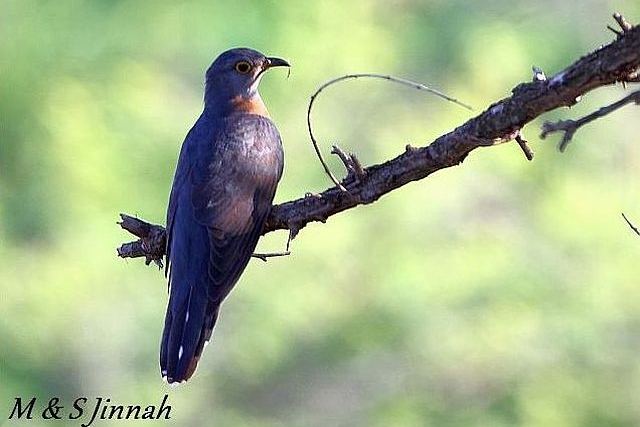 © Duke
© Duke
Borakalalo, North West
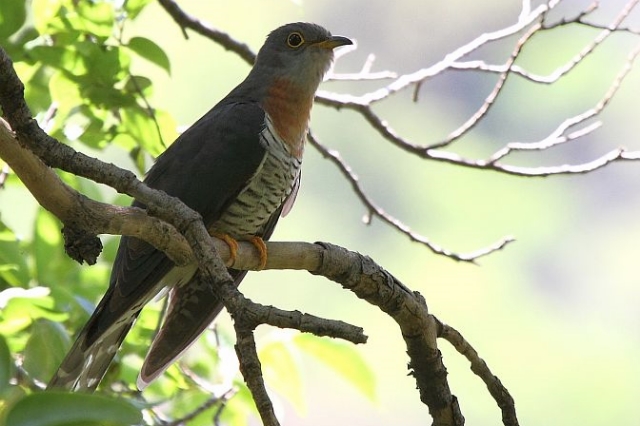 © Duke
© Duke
Walter Sisulu National Botanical Gardens, Johannesburg
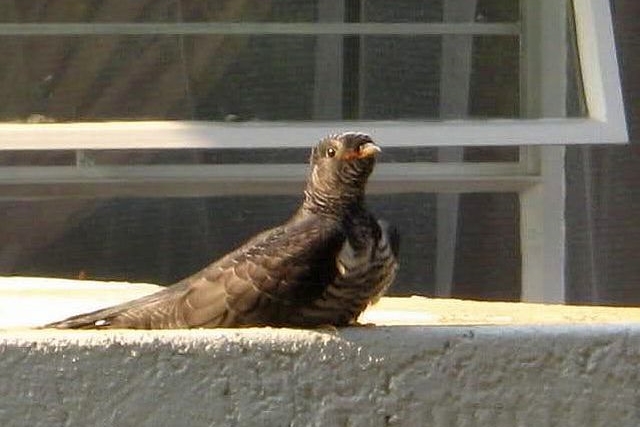 © Flutterby
© Flutterby
Juvenile
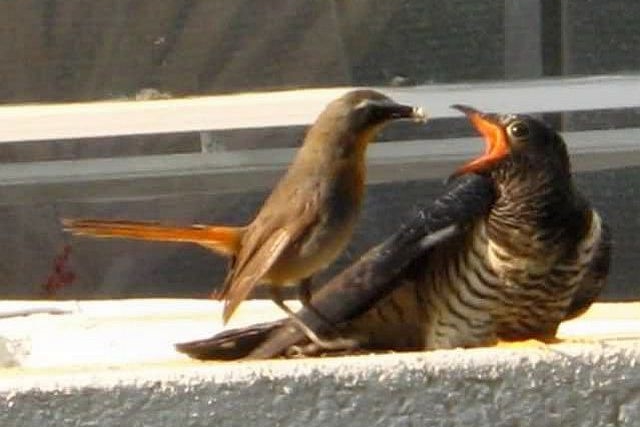 © Flutterby
© Flutterby
A Cape Robin-Chat feeding a juvenile Red-chested Cuckoo. The Cape Robin-Chat is often parasitised by the Red-chested Cuckoo and is then left to feed the baby!
Links:
Species text Sabap1
Sabap2
 © Lowveldboy
© Lowveldboy  © Duke
© Duke © Duke
© Duke © Duke
© DukeBorakalalo, North West
 © Duke
© DukeWalter Sisulu National Botanical Gardens, Johannesburg
 © Flutterby
© FlutterbyJuvenile
 © Flutterby
© FlutterbyA Cape Robin-Chat feeding a juvenile Red-chested Cuckoo. The Cape Robin-Chat is often parasitised by the Red-chested Cuckoo and is then left to feed the baby!
Links:
Species text Sabap1
Sabap2
-
Michele Nel
- Posts: 1994
- Joined: Mon Sep 10, 2012 10:19 am
- Country: South Africa
- Location: Cape Town
- Contact:
African Cuckoo
375. African Cuckoo Cuculus gularis (Afrikaanse Koekoek)
Order: Cuculiformes. Family: Cuculidae
Description
32 cm. Dark ashey grey upperparts, with a whitish tipped, blackish tail with barred undertail. Ashey-grey wings. Chin to breast ashy-grey, rest of underparts white. Yellow or yellow-orange legs and feet. Conspicuous yellow gape. Eye ring and iris yellow. Sexes similar.
Ad male: Upper parts dark ashy grey. Tail blackish, tipped white. Rectrices edged grey, with white spots along shafts. Outer 3 pairs with white spots along edges. Wings ashy grey above. Underwing ashy grey, primaries with broad whitish bars, secondaries with narrower whitish bars. Chin to upper breast ashy grey, belly and undertail coverts white, narrowly barred black. Undertail blackish, with broad whitish bars on proximal half, narrower bars distally. Bill blackish, upper mandible yellow at base, lower mandible mostly yellow, with black tip. Eyes and eye ring yellow. Legs and feet yellow or yellow-orange.
Similar species: Scarcely differs from male Common Cuckoo, but differs in having a broader, deeper bill, yellow at base, and broader whitish bars on underwing and undertail. Call distinctive (Common Cuckoo silent in s Africa). Moult aids identification. In Oct-Nov, African Cuckoo in fresh plumage, Common Cuckoo worn. Situation reversed Mar-Apr. Juv differs from juv Common Cuckoo in lacking tan or brown in plumage and having broader white spots on outer webs of rectrices.
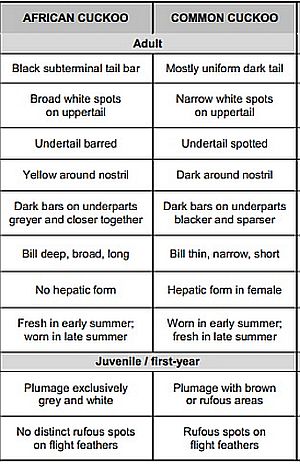
Distribution
Occurs across sub-Saharan Africa, absent only from parts of the DRC and Somalia. In southern Africa it is fairly common in northern and central Namibia, Botswana, Zimbabwe, Mozambique and north-eastern South Africa.
Habitat: Open woodland and Acacia savanna, avoids evergreen forest.
Movements and migrations
Intra-African breeding migrant, arriving in southern Africa around August-September, going through its full breeding cycle before departing around March-April.
Diet
Its diet is almost exclusively made up of caterpillars, foraging amongst the foliage of trees and shrubs, occasionally flying to the ground to pick up a prey item.
Breeding
It is a brood parasite, meaning that it lays its eggs in other birds nests. The host (usually a Fork-tailed Drongo), thinking that the egg is its own, incubates the egg and cares for the chick. Egg-laying season is from September-December, peaking from October-November. Both sexes participate in the egg-laying process: the male distracts the hosts while the female flies in to the drongo's nest, removes any existing eggs before laying one of her own. Eggs are incubated by the host for 11-17 days. The chick removes any existing Drongo eggs in the nest, eventually leaving the nest at about 23 days old.
Call
Hoop-hoop. Listen to Bird Call.
Status
Fairly common summer resident.
Order: Cuculiformes. Family: Cuculidae
Description
32 cm. Dark ashey grey upperparts, with a whitish tipped, blackish tail with barred undertail. Ashey-grey wings. Chin to breast ashy-grey, rest of underparts white. Yellow or yellow-orange legs and feet. Conspicuous yellow gape. Eye ring and iris yellow. Sexes similar.
Ad male: Upper parts dark ashy grey. Tail blackish, tipped white. Rectrices edged grey, with white spots along shafts. Outer 3 pairs with white spots along edges. Wings ashy grey above. Underwing ashy grey, primaries with broad whitish bars, secondaries with narrower whitish bars. Chin to upper breast ashy grey, belly and undertail coverts white, narrowly barred black. Undertail blackish, with broad whitish bars on proximal half, narrower bars distally. Bill blackish, upper mandible yellow at base, lower mandible mostly yellow, with black tip. Eyes and eye ring yellow. Legs and feet yellow or yellow-orange.
Similar species: Scarcely differs from male Common Cuckoo, but differs in having a broader, deeper bill, yellow at base, and broader whitish bars on underwing and undertail. Call distinctive (Common Cuckoo silent in s Africa). Moult aids identification. In Oct-Nov, African Cuckoo in fresh plumage, Common Cuckoo worn. Situation reversed Mar-Apr. Juv differs from juv Common Cuckoo in lacking tan or brown in plumage and having broader white spots on outer webs of rectrices.

Distribution
Occurs across sub-Saharan Africa, absent only from parts of the DRC and Somalia. In southern Africa it is fairly common in northern and central Namibia, Botswana, Zimbabwe, Mozambique and north-eastern South Africa.
Habitat: Open woodland and Acacia savanna, avoids evergreen forest.
Movements and migrations
Intra-African breeding migrant, arriving in southern Africa around August-September, going through its full breeding cycle before departing around March-April.
Diet
Its diet is almost exclusively made up of caterpillars, foraging amongst the foliage of trees and shrubs, occasionally flying to the ground to pick up a prey item.
Breeding
It is a brood parasite, meaning that it lays its eggs in other birds nests. The host (usually a Fork-tailed Drongo), thinking that the egg is its own, incubates the egg and cares for the chick. Egg-laying season is from September-December, peaking from October-November. Both sexes participate in the egg-laying process: the male distracts the hosts while the female flies in to the drongo's nest, removes any existing eggs before laying one of her own. Eggs are incubated by the host for 11-17 days. The chick removes any existing Drongo eggs in the nest, eventually leaving the nest at about 23 days old.
Call
Hoop-hoop. Listen to Bird Call.
Status
Fairly common summer resident.
-
Michele Nel
- Posts: 1994
- Joined: Mon Sep 10, 2012 10:19 am
- Country: South Africa
- Location: Cape Town
- Contact:
African Cuckoo Photos
375. African Cuckoo Cuculus gularis
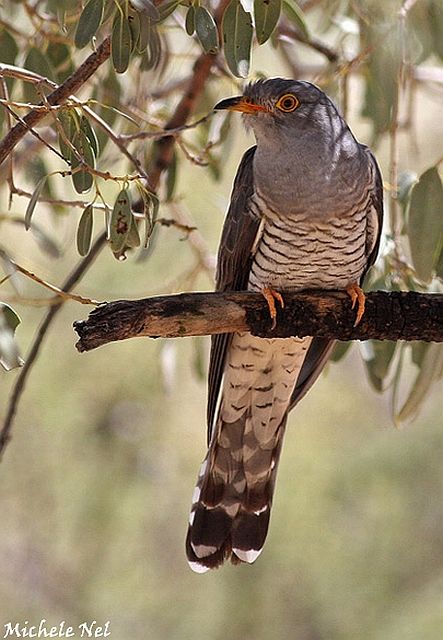 © Michele Nel
© Michele Nel
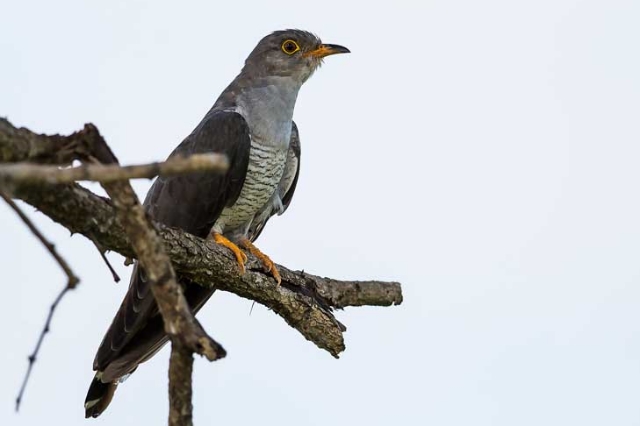 © Pumbaa
© Pumbaa
Kruger National Park
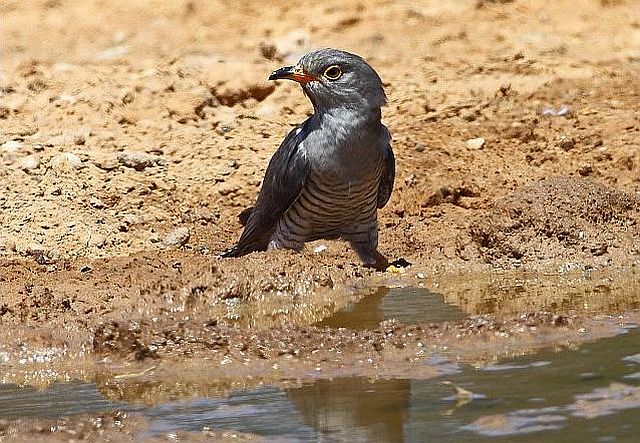 © Duke
© Duke
Kgalagadi Transfrontier Park
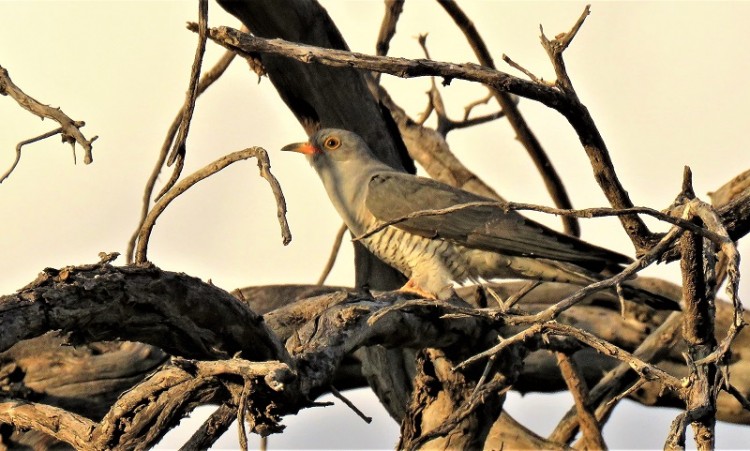 © Lisbeth
© Lisbeth
Kgalagadi Transfrontier Park, Mata Mata, Nov. 2017
Links:
Species text Sabap1
Sabap2: http://sabap2.adu.org.za/spp_summary.ph ... §ion=3
Cuckoo about cuckoos: identification of Common and African cuckoos re-examined. Ornithological Observations 2014 5:411-430 http://oo.adu.org.za/pdf/OO_2014_05_411-430.pdf
 © Michele Nel
© Michele Nel © Pumbaa
© PumbaaKruger National Park
 © Duke
© DukeKgalagadi Transfrontier Park
Kgalagadi Transfrontier Park, Mata Mata, Nov. 2017
Links:
Species text Sabap1
Sabap2: http://sabap2.adu.org.za/spp_summary.ph ... §ion=3
Cuckoo about cuckoos: identification of Common and African cuckoos re-examined. Ornithological Observations 2014 5:411-430 http://oo.adu.org.za/pdf/OO_2014_05_411-430.pdf
- nan
- Posts: 26454
- Joined: Thu May 31, 2012 9:41 pm
- Country: Switzerland
- Location: Central Europe
- Contact:
Common Cuckoo
374. Common Cuckoo (formerly European Cuckoo) Cuculus canorus (Europese Koekoek)
Order: Cuculiformes. Family: Cuculidae
Description
Size 32-34 cm.
All adult males are slate-grey; the grey throat extends well down the bird's breast with a sharp demarcation to the barred underparts. The iris, orbital ring, the base of the bill and feet are yellow. Adult male best told by yellow-orange confined to base of bill and outer tail feathers spotted not barred (very hard to see).
Female is almost similar, except the upper breast which is rather rufous than grey. Grey adult females have a pinkish-buff or buff background to the barring and neck sides, and sometimes small rufous spots on the median and greater coverts and the outer webs of the secondary feathers. Female occurs in a rare rufous colour form. Rufous morph adult females have reddish-brown upperparts with dark grey or black bars. The black upperpart bars are narrower than the rufous bars, as opposed to rufous juvenile birds, where the black bars are broader
Juveniles may be brown, grey or chestnut; the upperparts are usually barred, with the feathers tipped with white; the underparts are heavily barred. The most obvious identification features of juvenile Common Cuckoos are the white nape patch and white feather fringes.
Similar species: This bird may be mistaken for a small hawk in flight.
Virtually indistinguishable in appearance from African Cuckoo except on udertail pattern; African Cuckoo has a barred undertail, whereas Common Cuckoo has a spotted undertail. Common Cuckoo is generally less yellow on the bill than African Cuckoo, but not consistently so.
Distribution
Breeds across Eurasia, from the Iberian Peninsula east to Siberia and south to Japan and the Mediterranean; in the non-breeding season it heads south it to sub-Saharan Africa. In southern Africa it is locally common in central and northern Namibia (including the Caprivi Strip), Botswana, Zimbabwe, central Mozambique and eastern South Africa. The Common Cuckoo is a nonbreeding Palearctic migrant to western, central and southern Africa. In southern Africa it occurs mainly east of 25°E, extending westwards into northern Botswana, northern Namibia and the southern Cape Province.
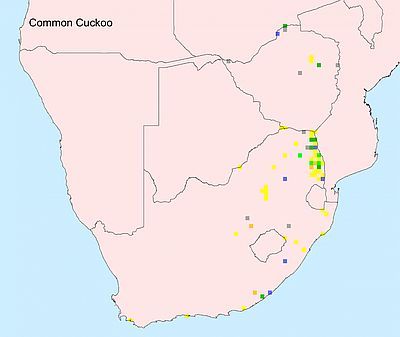
Taxonomy
There are four subspecies worldwide:
C. c. canorus, the nominate subspecies, occurs from the British Isles through Scandinavia, north Russia and Siberia to Japan in the east, and from the Pyrenees through Turkey, Kazakhstan, Mongolia, northern China and Korea. It winters in Africa and south Asia.
C. c. bakeri, breeds in western China to the Himalayan foothills in northern India, Nepal, Myanmar, north-west Thailand and southern China. During winter it is found in Assam, East Bengal and south-east Asia.
C. c. bangsi breeds in Iberia, the Balearic Islands and north Africa, spending winter in Africa.
C. c. subtelephonus, breeds in central Asia from Turkestan to southern Mongolia. It migrates to southern Asia and Africa for winter.
Habitat
Diverse; woodland, savanna, riverine forest and plantations.
Movements
The entire European and part of the Asiatic population spend the nonbreeding season south of the equator, mostly south of 10°S. Asian birds probably cross the Indian Ocean to make landfall on the African east coast, and there is regular vagrancy to southern ocean islands. First arrivals are in October; the main arrival period is in early November and it appears to be later further south, where the period of peak occurrence is January–February. The last birds leave in April.
Diet
Eats mainly caterpillars, doing most of its foraging by gleaning prey from leaves and branches.
Breeding
It is a brood parasite. Individual females prefer certain foster birds, and lay eggs that closely mimic those of the foster species. A female will establish a territory encompassing a number of potential foster nests, and carefully observe activity, waiting until the nests are at the right stage. She then swiftly takes her chance, swooping down, ejecting an egg and laying one of her own. The unsuspecting host bird then incubates and feeds the impostor, who removes other eggs and young from the nest and often grows much larger than its foster parent. Female cuckoos usually lay fewer than 12 eggs in 12 different host nests each year.
Call
Silent in the region.
Status
Scarce to locally common summer visitor.
Order: Cuculiformes. Family: Cuculidae
Description
Size 32-34 cm.
All adult males are slate-grey; the grey throat extends well down the bird's breast with a sharp demarcation to the barred underparts. The iris, orbital ring, the base of the bill and feet are yellow. Adult male best told by yellow-orange confined to base of bill and outer tail feathers spotted not barred (very hard to see).
Female is almost similar, except the upper breast which is rather rufous than grey. Grey adult females have a pinkish-buff or buff background to the barring and neck sides, and sometimes small rufous spots on the median and greater coverts and the outer webs of the secondary feathers. Female occurs in a rare rufous colour form. Rufous morph adult females have reddish-brown upperparts with dark grey or black bars. The black upperpart bars are narrower than the rufous bars, as opposed to rufous juvenile birds, where the black bars are broader
Juveniles may be brown, grey or chestnut; the upperparts are usually barred, with the feathers tipped with white; the underparts are heavily barred. The most obvious identification features of juvenile Common Cuckoos are the white nape patch and white feather fringes.
Similar species: This bird may be mistaken for a small hawk in flight.
Virtually indistinguishable in appearance from African Cuckoo except on udertail pattern; African Cuckoo has a barred undertail, whereas Common Cuckoo has a spotted undertail. Common Cuckoo is generally less yellow on the bill than African Cuckoo, but not consistently so.
Distribution
Breeds across Eurasia, from the Iberian Peninsula east to Siberia and south to Japan and the Mediterranean; in the non-breeding season it heads south it to sub-Saharan Africa. In southern Africa it is locally common in central and northern Namibia (including the Caprivi Strip), Botswana, Zimbabwe, central Mozambique and eastern South Africa. The Common Cuckoo is a nonbreeding Palearctic migrant to western, central and southern Africa. In southern Africa it occurs mainly east of 25°E, extending westwards into northern Botswana, northern Namibia and the southern Cape Province.

Taxonomy
There are four subspecies worldwide:
C. c. canorus, the nominate subspecies, occurs from the British Isles through Scandinavia, north Russia and Siberia to Japan in the east, and from the Pyrenees through Turkey, Kazakhstan, Mongolia, northern China and Korea. It winters in Africa and south Asia.
C. c. bakeri, breeds in western China to the Himalayan foothills in northern India, Nepal, Myanmar, north-west Thailand and southern China. During winter it is found in Assam, East Bengal and south-east Asia.
C. c. bangsi breeds in Iberia, the Balearic Islands and north Africa, spending winter in Africa.
C. c. subtelephonus, breeds in central Asia from Turkestan to southern Mongolia. It migrates to southern Asia and Africa for winter.
Habitat
Diverse; woodland, savanna, riverine forest and plantations.
Movements
The entire European and part of the Asiatic population spend the nonbreeding season south of the equator, mostly south of 10°S. Asian birds probably cross the Indian Ocean to make landfall on the African east coast, and there is regular vagrancy to southern ocean islands. First arrivals are in October; the main arrival period is in early November and it appears to be later further south, where the period of peak occurrence is January–February. The last birds leave in April.
Diet
Eats mainly caterpillars, doing most of its foraging by gleaning prey from leaves and branches.
Breeding
It is a brood parasite. Individual females prefer certain foster birds, and lay eggs that closely mimic those of the foster species. A female will establish a territory encompassing a number of potential foster nests, and carefully observe activity, waiting until the nests are at the right stage. She then swiftly takes her chance, swooping down, ejecting an egg and laying one of her own. The unsuspecting host bird then incubates and feeds the impostor, who removes other eggs and young from the nest and often grows much larger than its foster parent. Female cuckoos usually lay fewer than 12 eggs in 12 different host nests each year.
Call
Silent in the region.
Status
Scarce to locally common summer visitor.
Kgalagadi lover… for ever
https://safrounet.piwigo.com/
https://safrounet.piwigo.com/
- nan
- Posts: 26454
- Joined: Thu May 31, 2012 9:41 pm
- Country: Switzerland
- Location: Central Europe
- Contact:
Common Cuckoo Photos
374. Common Cuckoo Cuculus canorus (Europese Koekoek)
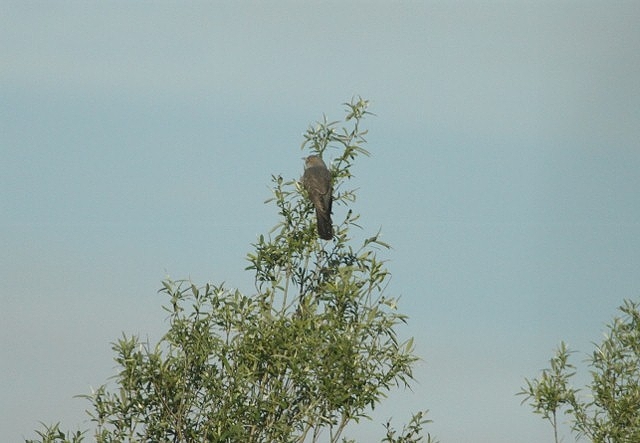
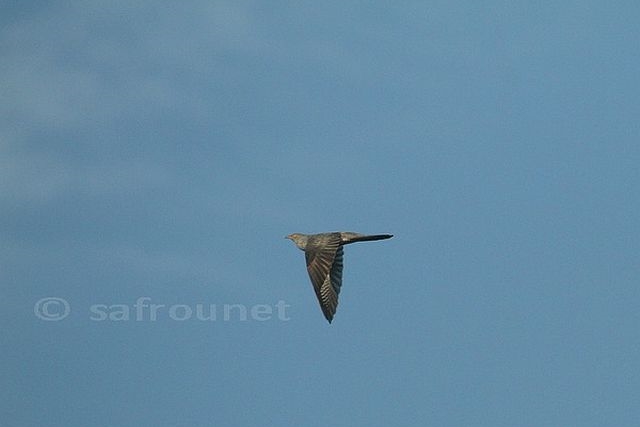
Switzerland
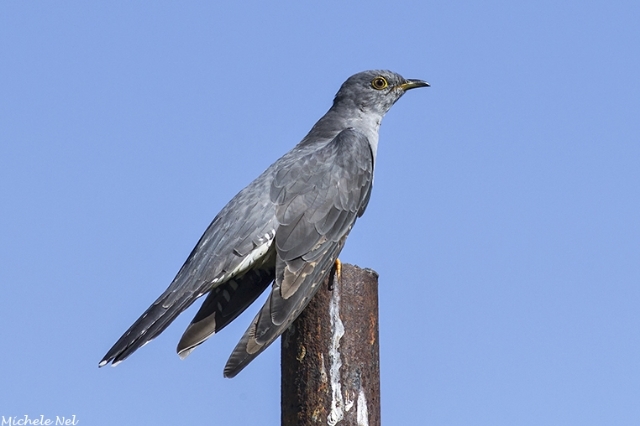 © Michele Nel
© Michele Nel
Farm in the Western Cape
Links:
Species text in The Atlas of Southern African Birds
Sabap2
Oiseaux net
The Atlas of Bird Migration: Tracing the Great Journeys of the World's Birds
Cuckoo about cuckoos: identification of Common and African cuckoos re-examined. Ornithological Observations 2014 5:411-430


Switzerland
 © Michele Nel
© Michele NelFarm in the Western Cape
Links:
Species text in The Atlas of Southern African Birds
Sabap2
Oiseaux net
The Atlas of Bird Migration: Tracing the Great Journeys of the World's Birds
Cuckoo about cuckoos: identification of Common and African cuckoos re-examined. Ornithological Observations 2014 5:411-430
Kgalagadi lover… for ever
https://safrounet.piwigo.com/
https://safrounet.piwigo.com/


